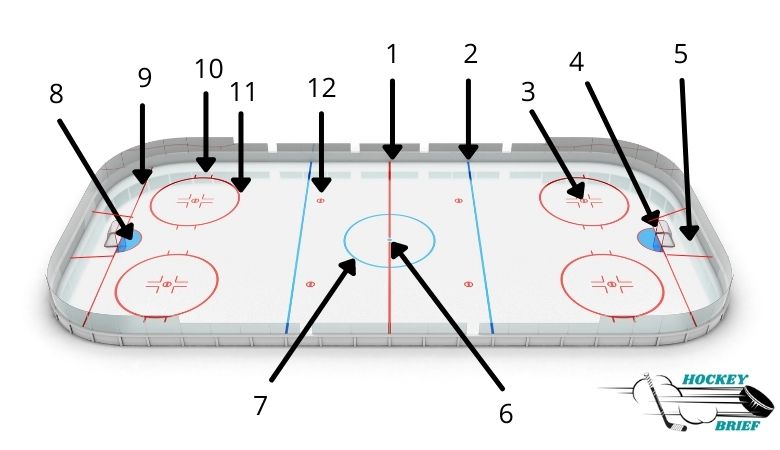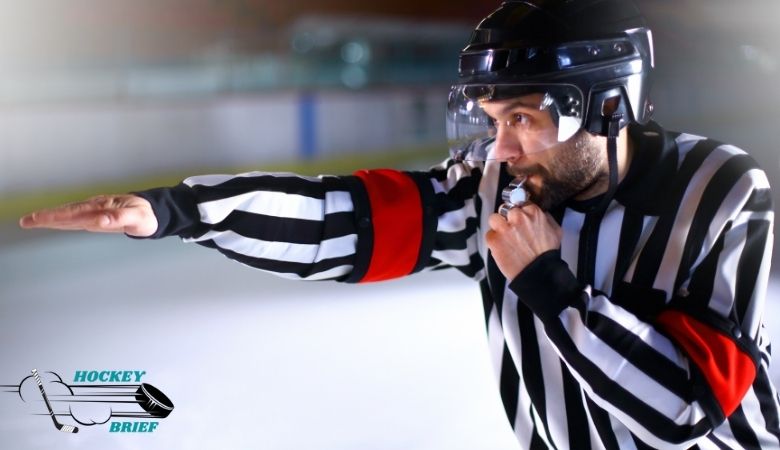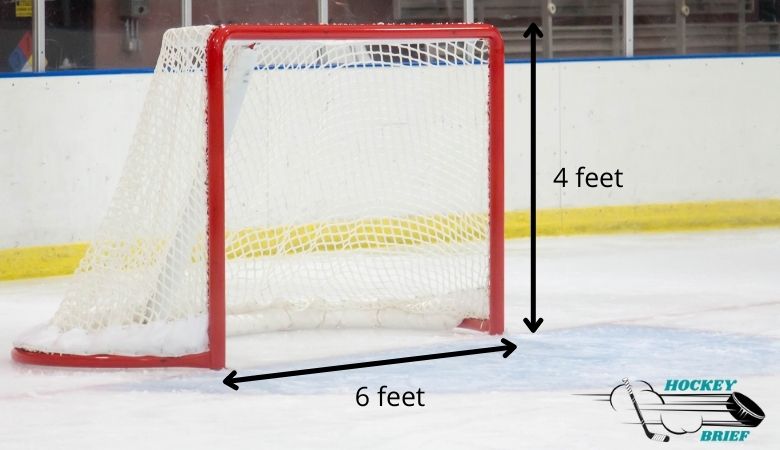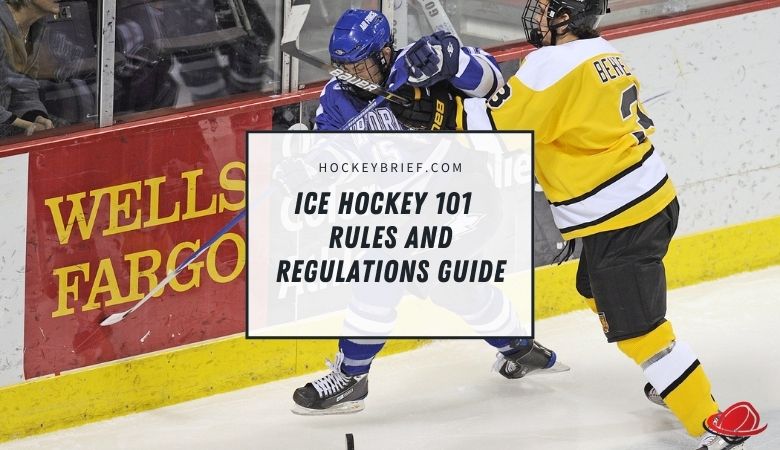There are several rules and regulations about the game of ice hockey that are essential to understand if you are new to the game.
Even if you have been playing for a while, knowing the rules of the game and improving your overall game knowledge will help you be a better player.
Although I won’t be covering every rule in the book, this article will show you many of the basic rules and regulations that every ice hockey player should know.

Aim of game
The aim or overall objective of the game of ice hockey is quite simple. Score more goals than the other team to win the game. Goals are scored when a player shoots the puck into the goal net of the opposing team.
Ice layout
Ice hockey is played on a 200-foot long sheet of ice which is 85 feet wide. 2 goal nets are used, one placed at each end of the ice, and they are placed 11 feet away from the boards.
Red and blue lines, circles, and other markings are used on the ice and each one is important for one reason or another.
See the following image which shows the different markings on the ice surface.

- Center ice line
- Blue line – offensive/defensive zones
- Faceoff dot
- Goal net
- Trapezoid
- Center ice faceoff dot
- Center ice circle
- Goal crease
- Goal line
- Hash marks
- Faceoff circle
- Neutral zone faceoff dot
Game length
Ice hockey is divided into 3 periods which are 20 minutes long each. Most professional hockey leagues like the NHL, use 20 minute periods.
Some minor leagues, including kids and recreational leagues, will use 20 minute periods of continuous time. The clock doesn’t stop as it does in pro leagues. If the game score is tied after regulation play, overtime rules apply.
In overtime, a period of 5 minutes is played unless one team scores a goal. If no team scores in overtime, a shootout will decide the game-winner.
During the playoffs, the rules are different for overtime play. 20 minute periods are used and continue until a goal is scored.
Players
The following players are used in a game of ice hockey.
- Forwards
- Defencemen
- Goaltender
The forwards are broken down into centermen and wingers.
During even-strength play, there will be 5 players and a goaltender on the ice for each time.
- 1 Center
- 2 Wingers
- 2 Defencemen
- 1 Goalie
If your team is short-handed while killing a penalty, there can be either 4 or 3 players on the ice giving the other team an advantage known as a power play.
Officials/Referees
The ice hockey officials are used to ensure that all the rules of the game are being followed by everyone involved including the players and coaches. The job of an official can be quite complex as they are responsible for enforcing all regulations in the rule book.
During a game, there will be 4 on-ice officials. 2 referees, and 2 linesmen. The referees are in charge of the full officiating team and are responsible for calling penalties.
The linesmen are responsible for calling plays during the game such as offsides and icing. They will also bring something to the attention of the referee if it was missed or the referee needs clarification.
The 2 referees wear orange-colored bands on the arms of their uniform where the 2 linesmen do not.
Other officials used during the game include a goal judge and an official scorekeeper.

Penalties
Penalties are a big part of the game of hockey. As mentioned, all players and coaches are responsible for their own conduct and can be charged with a penalty if a violation of the rule book occurs.
Penalties are broken down into classifications.
- Minor penalties
- Major penalties
- Misconduct penalties
- Game misconduct penalties
- Match penalties
There are 17 different minor penalties that can be called on any player. These are normally 2-minute penalties but it’s possible for a double minor to be called which is 4 minutes long.
Major penalties include:
- Fighting
- Checking from behind
- High sticking
- Hit to the head
- Instigating a fight
- Leaving the bench to join an altercation
Major penalties normally involve a 5-minute penalty or a 4-minute major penalty if the infraction causes another player to bleed.
Misconduct penalties will normally force a player to sit in the penalty box for 10 minutes. They are more serious than minor and major penalties that don’t force the player to be ejected from the game.
A game misconduct penalty is similar to a regular misconduct with the difference being the player is ejected from the game. The player could also be subject to a fine.
A match penalty will result in an automatic ejection from the game and the team will be forced to play shorthanded for 5 minutes.
You can read a complete list of penalties with explanations of each here.
Faceoffs
Faceoffs take place after a stoppage in play. 2 players will line up at one of the faceoff dots in the faceoff circle in an attempt to win the puck dropped by one of the linesmen. There are 9 faceoff dots and 5 faceoff circles on the ice surface.
Icing
Icing the puck is another big part of the game where a player shoots the puck prior to reaching the center ice line into the other team’s zone and crosses the red line. The linesman is responsible for calling an icing. There are other rules and factors that affect icing the puck which you can read here.
Offsides
An offside call is made by a linesman if a player crosses into the offensive zone by passing the blue line ahead of the puck. The puck must cross the blue line first or an offside will be called resulting in a stoppage in play.
Ice hockey rules and regulations – FAQ’s
Where can I find the ice hockey rulebook?
The official rules NHL handbook can be found here.
Is icing still called if the puck deflects off of another player?
Yes, an icing will still be called if the player on the same team has not reached center ice prior to the puck hitting them.
How many players are on each team?
Both teams must dress a minimum of 18 players plus 2 goaltenders for a total of 20. The maximum number of players allowed is 23. So any range between 20-23 players is allowed.
What are the dimensions of the goal net used in ice hockey?
Each goal net used must be 6 feet long and 4 feet tall.

What is a trapezoid?
The trapezoid is an area designated behind the goaltender’s net where they can play the puck without a penalty being called.
How many players are credited with a point when a goal is scored?
Up to 3 points can be awarded to the players when a goal is scored. The player who scored the goal and up to 2 assists may be awarded to the players who passed the puck to the goal scorer. Only one assist will be given if the puck was touched by the opposing team after a pass.
Are NHL hockey sticks the same size?
No, not all players use the same sized stick. They can range in size. The maximum size for a stick in the NHL is 63 inches long which is 3 inches longer than 5 feet.

